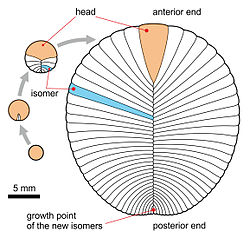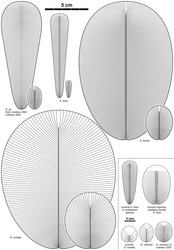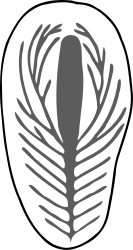User:Hemiauchenia/Dickinsonia
| Hemiauchenia/Dickinsonia Temporal range: Late Ediacaran,
| |
|---|---|

| |
| Cast of Dickinsonia costata from Australia | |
| Scientific classification | |
| Domain: | Eukaryota |
| Kingdom: | Animalia |
| Phylum: | †Proarticulata |
| Class: | †Dipleurozoa |
| Family: | †Dickinsoniidae |
| Genus: | †Dickinsonia Sprigg, 1947 |
| Type species | |
| †Dickinsonia costata Sprigg, 1947
| |
| Species | |
| |
| Synonyms | |
|
D. costata Synonymy
D. tenuis Synonymy
| |
Dickinsonia is a genus of extinct organism that lived during the late Ediacaran period in what is now Australia, China, Russia and Ukraine, most likely a basal animal. The individual Dickinsonia typically resembles a bilaterally symmetrical ribbed oval. Its affinities are presently unknown; its mode of growth has been considered consistent with a stem-group bilaterian affinity,[3] It has also been suggested has been an "extinct kingdom".[4][5][6] The discovery of cholesterol molecules in fossils of Dickinsonia lends support to the idea that Dickinsonia was an animal,[7] though these results have been questioned.[8]
Description
[edit]Dickinsonia fossils are known only in the form of imprints and casts in sandstone beds. The specimens found range from a few millimetres to about 1.4 metres (4 ft 7 in) in length, and from a fraction of a millimetre to a few millimetres thick.[9] They are nearly bilaterally symmetric, segmented, round or oval in outline, slightly expanded to one end (i.e. egg-shaped outline). The rib-like segments are radially inclined towards the wide and narrow ends, and the width and length of the segments increases towards the wide end of the fossil.[2][10] Often a midline ridge or groove is observed,[2][10] though this appears to be absent in some specimens.[11] Is it disputed whether the segments are offset from each other following glide reflection, and are thus isomers,[2][10][12] or whether the segments are continuous and symmetric, and thus follow true bilateral symmetry, as the specimens displaying the offset may be the result of taphonomic distortion.[11][13] The number of segments/isomer pairs varies from 12 in smaller individuals to 74 in the largest Australian specimens.[13]
The body of Dickinsonia is suggested to have been sack-like, with the outer layer being made of a resistant but unmineralised material.[14] Some specimens from Russia show the presence of branched internal structures.[15][14] Some authors have suggested that the underside of the body bore cilia, as well as bearing infolded pockets.[14]
Dickinsonia is suggested to have grown by adding a new segment/pair of isomers at the end opposite the unpaired "anterior most unit" presumed to represent the front of the animal.[11]
Ecology
[edit]Dickinsonia is suggested to have been a mobile marine organism that fed by consuming microbial mats using structures present its underside. Dickinsonia-shaped trace fossils, presumed to represent feeding impressions, sometimes found in chains demonstrating this behaviour have been observed.[14] These trace fossils have been assigned to the genera Epibaion and Phyllozoon.[16][17][18]
Discovery
[edit]The first species and specimens of this fossil organism were first discovered in the Ediacara Member of the Rawnsley Quartzite, Flinders Ranges in South Australia. Reg Sprigg, the original discoverer of the Ediacaran biota in Australia,[19] described Dickinsonia, naming it after Ben Dickinson, then Director of Mines for South Australia, and head of the government department that employed Sprigg.[20] Additional specimens of Dickinsonia are also known from the Mogilev Formation in the Dniester River Basin of Podolia, Ukraine,[21] the Lyamtsa, Verkhovka, Zimnegory and Yorga Formations in the White Sea area of the Arkhangelsk Region, Chernokamen Formation of the Central Urals, Russia,[22] (these deposits have been dated to 567–550 Myr.[23][24][25]), the Dengying Formation in the Yangtze Gorges area, South China. (ca. 551–543 Ma).[26]
Taphonomy
[edit]As a rule, Dickinsonia fossils are preserved as negative impressions ("death masks") on the bases of sandstone beds. Such fossils are imprints of the upper sides of the benthic organisms that have been buried under the sand.[27][28] The imprints formed as a result of cementation of the sand before complete decomposition of the body. The mechanism of cementation is not quite clear; among many possibilities, the process could have arisen from conditions which gave rise to pyrite "death masks"[28] on the decaying body, or perhaps it was due to the carbonate cementation of the sand.[29] The imprints of the bodies of organisms are often strongly compressed, distorted, and sometimes partly extend into the overlying rock. These deformations appear to show attempts by the organisms to escape from the falling sediment.[30][31][32]
Rarely, Dickinsonia have been preserved as a cast in massive sandstone lenses, where it occurs together with Pteridinium, Rangea and some others.[33][34][35][36] These specimens are products of events where organisms were first stripped from the sea-floor, transported and deposited within sand flow.[33][36] In such cases, stretched and ripped Dickinsonia occur. The first such specimen was described as a separate genus and species, Chondroplon bilobatum[37] and later re-identified as Dickinsonia.
Taxonomy
[edit]Species
[edit]Since 1947, a total of nine species have been described, of which three are currently considered valid:[38]
| Species | Authority | Location | Status | Notes |
|---|---|---|---|---|
| Dickinsonia brachina [39] | Wade, 1972 | Australia | invalid | Synonym of Dickinsonia tenuis |
| Dickinsonia costata [40] | Sprigg, 1947 | Australia, Russia and Ukraine | valid | Unlike other species, D. costata has comparatively rounded body and fewer, wider segments / isomers. |
| Dickinsonia elongata [41] | Glaessner & Wade, 1966 | Australia | invalid | Synonym of Dickinsonia costata |
| Dickinsonia lissa[39] | Wade, 1972 | Australia | invalid | Synonym of Dickinsonia tenuis |
| Dickinsonia menneri[42] | Keller, 1976 | Russia | valid | D. menneri is a small organism up to 8 mm in length, and strongly resembles juvenile specimens of D. costata with its small number of isomers and well-marked head. D. menneri differs from juvenile D. costata by its slightly more elongated form.
Originally classified as Vendomia, it was re-identified as Dickinsonia by Ivantsov (2007)[43] |
| Dickinsonia minima [44] | Sprigg, 1949 | Australia | invalid | Synonym of Dickinsonia costata |
| Dickinsonia rex [45] | Jenkins, 1992 | Australia | invalid | Synonym of Dickinsonia tenuis |
| Dickinsonia spriggi [46] | Harrington & Moore, 1955 | Australia | invalid | Synonym of Dickinsonia costata |
| Dickinsonia tenuis [41] | Glaessner & Wade, 1966 | Australia and Russia | valid | Strongly resembles D. costata, but differs from it by more narrow and numerous segments, sparingly lengthened oval form of the body. |
External relationships
[edit]Dickinsonia is classified as part of the group Proarticulata or Dickinsoniomorpha.[14] Proarticulata includes a number of morphologically similar organisms, such Spriggina, Yorgia, Andiva and Cephalonega, which share the same segmented articulation.[47] The affinities of Proarticulata to other organisms, including to other members of the Ediacaran biota, like rangeomorphs, have long been contentious.[7] Gregory Retallack has proposed that the fossils of Dickinsonia and other Ediacaran biota represent lichens that were deposited in a terrestrial environment,[48] but this has been broadly rejected by other authors.[7][49] Other proposal have included giant protists, as proposed by Adolf Seilacher.[50] Many researchers suggest that Dickinsonia and other proarticulatans are likely to be animals, likely belonging to Eumetazoa.[11][14] A chemical study of Russian specimens found that they were enriched with cholesterol, which is only produced by animals, supporting an animal affinity,[7] though these results have been questioned by other authors.[8] Within Eumetazoa, a number of affinities have been proposed, including as stem-eumetazoans forming a clade with rangeomorphs,[51] to Placozoa,[52] and to Cnidaria.[53] A number of reseachers have proposed close affinities to Bilateria, based on the bilateral or nearly bilateral organisation of proarticulatans,[14][3] though proarticulatans are not likely to be a member of the bilaterian crown group.[11]
References
[edit]- ^ Hofmann, Hans J. (1988). "An alternative interpretation of the Ediacaran (Precambrian) chondrophore Chondroplon Wade". Alcheringa. 12 (4): 315–318. doi:10.1080/03115518808619130.
- ^ a b c d Ivantsov, A. Y. (2007). "Small Vendian transversely articulated fossils". Paleontological Journal. 41 (2): 113–122. doi:10.1134/S0031030107020013. S2CID 86636748.
- ^ a b Gold, D. A.; Runnegar, B.; Gehling, J. G.; Jacobs, D. K. (2015). "Ancestral state reconstruction of ontogeny supports a bilaterian affinity for Dickinsonia". Evolution & Development. 17 (6): 315–397. doi:10.1111/ede.12168. PMID 26492825. S2CID 26099557.
- ^ Pflug (1973). "Zur fauna der Nama-Schichten in Südwest-Afrika. IV. Mikroscopische anatomie der petalo-organisme". Palaeontographica (B144): 166–202.
- ^ Seilacher, Adolf (1992). "Vendobionta and Psammocorallia: lost constructions of Precambrian evolution". Journal of the Geological Society, London. 149 (4): 607–613. Bibcode:1992JGSoc.149..607S. doi:10.1144/gsjgs.149.4.0607. S2CID 128681462. Retrieved 2007-06-21.
- ^ McMenamin M. (1998). The Garden of Ediacara. New York: Columbia University Press. ISBN 978-0-231-10559-0. OCLC 228271905. It lived during the late Ediacaran (part of Precambrian). Dinosaurs a visual encyclopedia. New York: DK Publishing, Inc. 2018-04-03. ISBN 9781465469489.
- ^ a b c d Bobrovskiy, Ilya; Hope, Janet M.; Ivantsov, Andrey; Nettersheim, Benjamin J.; Hallmann, Christian; Brocks, Jochen J. (20 September 2018). "Ancient steroids establish the Ediacaran fossil Dickinsonia as one of the earliest animals". Science. 361 (6408): 1246–1249. Bibcode:2018Sci...361.1246B. doi:10.1126/science.aat7228. PMID 30237355.
- ^ a b Love, G.D.; Zumberge, J.A. (2021). "Emerging patterns in Proterozoic lipid biomarker records". Cambridge Elements. 361 (6408). doi:10.1017/9781108847117.
- ^ Fedonkin, 2 M. A.; Gehling, J. G.; Grey, K.; Narbonne, G. M.; Vickers-Rich, P. (2007). The Rise of Animals. Evolution and Diversification of the Kingdom Animalia. Johns Hopkins University Press. p. 326. ISBN 978-0-8018-8679-9.
{{cite book}}: CS1 maint: numeric names: authors list (link) - ^ a b c Ivantsov, A. Yu (2012). "Becoming metamery and bilateral symmetry in Metazoa: way of Proarticulata". Morphogenesis in the Individual and Historical Development: Symmetry and Asymmetry.: 16–17.
- ^ a b c d e Evans, Scott D.; Droser, Mary L.; Gehling, James G. (2017-05-17). Hejnol, Andreas (ed.). "Highly regulated growth and development of the Ediacara macrofossil Dickinsonia costata". PLOS ONE. 12 (5): e0176874. doi:10.1371/journal.pone.0176874. ISSN 1932-6203. PMC 5435172. PMID 28520741.
{{cite journal}}: CS1 maint: PMC format (link) CS1 maint: unflagged free DOI (link) - ^ Ivantsov, A. Y. (2011). "Feeding traces of Proarticulata — the Vendian metazoa". Paleontological Journal. 45 (3): 237–248. doi:10.1134/S0031030111030063. S2CID 128741869.
- ^ a b Dunn, Frances S.; Liu, Alexander G.; Donoghue, Philip C. J. (2018-05). "Ediacaran developmental biology". Biological Reviews. 93 (2): 914–932. doi:10.1111/brv.12379. ISSN 1464-7931. PMC 5947158. PMID 29105292.
{{cite journal}}: Check date values in:|date=(help)CS1 maint: PMC format (link) - ^ a b c d e f g Ivantsov, Andrey Yu; Zakrevskaya, Maria (2023-02-23). "Body plan of Dickinsonia , the oldest mobile animals". Earth and Environmental Science Transactions of the Royal Society of Edinburgh: 1–14. doi:10.1017/S175569102300004X. ISSN 1755-6910.
- ^ Ivantsov, A. Y. (2004). "New Proarticulata from the Vendian of the Arkhangel'sk Region" (PDF). Paleontological Journal. 38 (3): 247–253. Archived from the original (PDF) on 2007-09-27. Retrieved 2007-09-27.
- ^ Ivantsov, A. Y. (2011). "Feeding traces of Proarticulata — the Vendian metazoa". Paleontological Journal. 45 (3): 237–248. doi:10.1134/S0031030111030063. S2CID 128741869.
- ^ Ivantsov, A.Y. (2013). "Trace Fossils of Precambrian Metazoans "Vendobionta" and "Mollusks"". Stratigraphy and Geological Correlation. 21 (3): 252–264. Bibcode:2013SGC....21..252I. doi:10.1134/S0869593813030039. S2CID 128638405.
- ^ Ivantsov, A.Y.; Malakhovskaya, Y.E. (2002). "Giant Traces of Vendian Animals" (PDF). Doklady Earth Sciences. 385 (6): 618–622. Archived from the original (PDF) on 2007-07-04. Retrieved 2008-02-24.
- ^ Sprigg, Reg C. (1947). "Early Cambrian (?) jellyfishes from the Flinders Ranges, South Australia" (PDF). Trans. R. Soc. S. Aust. 71: 212–24. Archived from the original (PDF) on 2007-09-29.
- ^ Eig, Karsten. "EDIACARANS: THE FOSSILS THAT SHOULD NOT BE THERE". Adventures in geology - Karsten Eig.
- ^ Fedonkin, M. A. (1983). "Non-skeletal fauna of Podoloia, Dniester River valley". In Velikanov, V. A.; Assejeva, E. A.; Fedonkin, M. A. (eds.). The Vendian of the Ukraine (in Russian). Kiev: Naukova Dumka. pp. 128–139.
- ^ Fedonkin, 2 M. A.; Gehling, J. G.; Grey, K.; Narbonne, G. M.; Vickers-Rich, P. (2007). The Rise of Animals. Evolution and Diversification of the Kingdom Animalia. Johns Hopkins University Press. p. 326. ISBN 978-0-8018-8679-9.
{{cite book}}: CS1 maint: numeric names: authors list (link) - ^ Grazhdankin, Dima (2004). "Patterns of distribution in the Ediacaran biotas: facies versus biogeography and evolution" (PDF). Paleobiology. 30 (2): 203–221. doi:10.1666/0094-8373(2004)030<0203:PODITE>2.0.CO;2. S2CID 129376371.
- ^ Maslov, A.V.; Podkovyrov, V.N.; Grazhdankin, D.V.; Kolesnikov, A.V. (2018). "Upper Vendian in the east, northeast and north of East European Platform: Depositional processes and biotic evolution". Litosfera. 18 (4): 520–542. doi:10.24930/1681-9004-2018-18-4-520-542.
- ^ Kolesnikov, A.V.; Liu, A.G.; Danelian, T.; Grazhdankin, D.V. (2018). "A reassessment of the problematic Ediacaran genus Orbisiana Sokolov 1976". Precambrian Research. 316: 197–205. Bibcode:2018PreR..316..197K. doi:10.1016/j.precamres.2018.08.011. S2CID 134213721.
- ^ Wang, Xiao-Peng; Chen, Zhe; Pang, Ke; Zhou, Chuan-Ming; Xiao, Shuhai; Wan, Bin; Yuan, Xun-Lai (2021). "Dickinsonia from the Ediacaran Dengying Formation in the Yangtze Gorges area, South China". Palaeoworld. 30 (4): 602–609. doi:10.1016/j.palwor.2021.01.002. S2CID 234254399.
- ^ Ivantsov, A.Y. (2009). "A new reconstruction of Kimberella, a problematic Vendian Metazoan". Paleontological Journal. 43 (6): 601–611. doi:10.1134/S003103010906001X. S2CID 85676210.
- ^ a b Gehling, J.G. (1999). "Microbial mats in terminal Proterozoic siliciclastics; Ediacaran death masks". PALAIOS. 14 (1): 40–57. Bibcode:1999Palai..14...40G. doi:10.2307/3515360. JSTOR 3515360.
- ^ Serezhnikova Z, E.A. (2011). "Microbial Binding as a Probable Cause of Taphonomic Variability of Vendian Fossils: Carbonate Casting?". Advances in Stromatolite Geobiology. Lecture Notes in Earth Sciences. Vol. 131. pp. 525–535. doi:10.1007/978-3-642-10415-2_31. ISBN 978-3-642-10414-5.
- ^ Ivantsov, A. Y. (2011). "Feeding traces of Proarticulata — the Vendian metazoa". Paleontological Journal. 45 (3): 237–248. doi:10.1134/S0031030111030063. S2CID 128741869.
- ^ Ivantsov, A.Y. (2013). "Trace Fossils of Precambrian Metazoans "Vendobionta" and "Mollusks"". Stratigraphy and Geological Correlation. 21 (3): 252–264. Bibcode:2013SGC....21..252I. doi:10.1134/S0869593813030039. S2CID 128638405.
- ^ Runnegar, Bruce (1982). "Oxygen requirements, biology and phylogenetic significance of the late Precambrian worm Dickinsonia, and the evolution of the burrowing habit". Alcheringa: An Australasian Journal of Palaeontology. 6 (3): 223–239. doi:10.1080/03115518208565415.
- ^ a b Grazhdankin, Dima (2004). "Patterns of distribution in the Ediacaran biotas: facies versus biogeography and evolution" (PDF). Paleobiology. 30 (2): 203–221. doi:10.1666/0094-8373(2004)030<0203:PODITE>2.0.CO;2. S2CID 129376371.
- ^ Keller, B.M.; Fedonkin, M.A. (1976). "New records of fossils in the Valdaian group of the precambrian on the Syuz'ma River" (PDF). Izvestiya Akademii Nauk SSR. Seriya Geologicheskaya (in Russian). 3: 38–44. Archived from the original (PDF) on 2007-09-27.
- ^ Keller, B. M.; Fedonkin, M. A. (1977). "New organic fossil finds in the Precambrian Valday series along the Syuz'ma River". International Geology Review. 19 (8): 924–930. Bibcode:1977IGRv...19..924K. doi:10.1080/00206817709471091.
- ^ a b Gehling, J.G.; Droser, M.L. (2013). "How well do fossil assemblages of the Ediacara Biota tell time?". Geology. 41 (4): 447–450. Bibcode:2013Geo....41..447G. doi:10.1130/G33881.1.
- ^ Wade, M. (1971). "Bilateral Precambrian Chondrophores from the Ediacara Fauna, South Australia". Proceedings of the Royal Society of Victoria. 84 (1): 183–188.
- ^ Evans, S.D.; Hunt, G.; Gehling, J.G.; Sperling, E. A.; Droser, M.L. (2023). "Species of Dickinsonia Sprigg from the Ediacaran of South Australia". Palaeontology. 66 (e12635): 1–21. doi:10.1111/pala.12635.
- ^ a b Wade, M. (1972). "Dickinsonia: Polychaete worms from the late Precambrian Ediacara fauna, South Australia". Mem. Queensl. Mus. 16 (2): 171–190.
- ^ Sprigg, Reg C. (1947). "Early Cambrian (?) jellyfishes from the Flinders Ranges, South Australia" (PDF). Trans. R. Soc. S. Aust. 71: 212–24. Archived from the original (PDF) on 2007-09-29.
- ^ a b Glaessner, M.F.; Wade, M. (1966). "The late Precambrian fossils from Ediacara, South Australia" (PDF). Palaeontology. 9 (4): 599.
- ^ Keller, B.M.; Fedonkin, M.A. (1976). "New records of fossils in the Valdaian group of the precambrian on the Syuz'ma River" (PDF). Izvestiya Akademii Nauk SSR. Seriya Geologicheskaya (in Russian). 3: 38–44. Archived from the original (PDF) on 2007-09-27.
- ^ Ivantsov, A. Y. (2007). "Small Vendian transversely articulated fossils". Paleontological Journal. 41 (2): 113–122. doi:10.1134/S0031030107020013. S2CID 86636748.
- ^ Sprigg, R.C. (1949). "Early Cambrian "jellyfishes" of Ediacara, South Australia, and Mount John, Kimberley District, Western Australia" (PDF). Transactions of the Royal Society of South Australia. 73: 72–99.[permanent dead link]
- ^ Jenkins, R.J.F. (1992). "Functional and ecological aspects of Ediacarian assemblages". In Lipps, J.; Signor, P.W. (eds.). Origin and early evolution of the Metazoa. New York, NY: Springer. pp. 131–176. ISBN 978-0-306-44067-0. OCLC 231467647.
- ^ Harrington, N.J.; Moore, R.C. (1955). "Kansas Pennsylvanian and other jellyfishes". Bull. Kansas Geol. Surv. 114 (5): 153–163.
- ^ A.Y. Ivantsov; M.A. Fedonkin; A.L. Nagovitsyn; M.A. Zakrevskaya (2019). "Cephalonega, a new generic name, and the system of Vendian Proarticulata". Paleontological Journal. 53 (5): 447–454. doi:10.1134/S0031030119050046. S2CID 203853224.
- ^ Retallack, Gregory J. (2013-01). "Ediacaran life on land". Nature. 493 (7430): 89–92. doi:10.1038/nature11777. ISSN 0028-0836.
{{cite journal}}: Check date values in:|date=(help) - ^ Xiao, Shuhai; Droser, Mary; Gehling, James G.; Hughes, Ian V.; Wan, Bin; Chen, Zhe; Yuan, Xunlai (2014-03). "Affirming life aquatic for the Ediacara biota in China and Australia: REPLY". Geology. 42 (3): e326–e326. doi:10.1130/G35364Y.1. ISSN 1943-2682.
{{cite journal}}: Check date values in:|date=(help) - ^ Seilacher, A. (2007-01). "The nature of vendobionts". Geological Society, London, Special Publications. 286 (1): 387–397. doi:10.1144/SP286.28. ISSN 0305-8719.
{{cite journal}}: Check date values in:|date=(help) - ^ Hoyal Cuthill, Jennifer F.; Han, Jian (2018-11). Álvaro, Javier (ed.). "Cambrian petalonamid Stromatoveris phylogenetically links Ediacaran biota to later animals". Palaeontology. 61 (6): 813–823. doi:10.1111/pala.12393. ISSN 0031-0239.
{{cite journal}}: Check date values in:|date=(help) - ^ Sperling, Erik; et al. (2008). "A placozoan affinity for Dickinsonia and the evolution of late Precambrian metazoan feeding modes". Geological Society of America. Abstracts with Programs. 40 (6): 508. Archived from the original on 2018-02-28. Retrieved 2008-10-27.
- ^ J.W. Valentine Dickinsonia as a polypoid organism Paleobiology, 18 (1992), pp. 378-382



